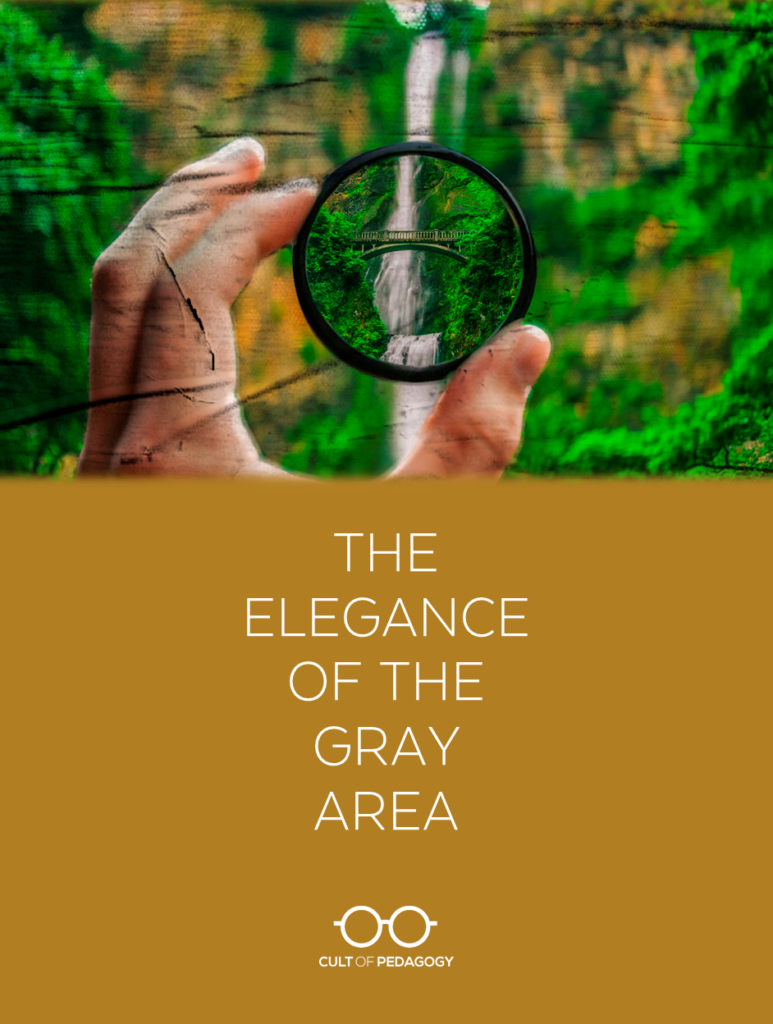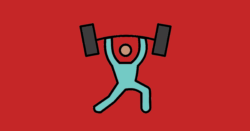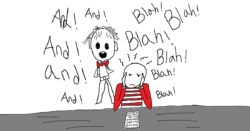
Listen to this post as a podcast:
Sponsored by Kialo Edu and Kiddom
I once observed an argument between two friends of mine. Two men in their twenties; we’ll call them Joe and Lee. At the time, I was developing a pretty good crush on Joe. I have zero memory of what they were arguing about, but at some point Joe leaned forward in his seat and said, “You’ve got to be kidding, Lee. Do you know what year women got the right to vote?”
Looking mildly panicked, Lee stammered for words, glancing around the diner we were sitting in as if the answer would pop up from another booth.
Joe let him squirm for a few seconds, then finally put him out of his misery. “Nineteen-eighteen, Lee,” he revealed, falling back and picking up his coffee with satisfaction. “Nineteen-eighteen.”
(If hearing this, you’re thinking Wait, that’s wrong. It was actually 1920. Just hang on. Also, this was before smartphones and Google, so no one could fact-check.)
Joe had employed a classic move: Make your opponent feel unsure, unsteady, intimidate them into thinking you’re smarter than them, and you’ll be well on your way to winning the argument. And it worked. Lee kind of withered, and Joe continued to pummel him until he gave in.
And even though Joe was being kind of a dick, and I didn’t know the answer either, and I hated it for Lee, Joe’s confidence was impressive. I couldn’t help but crush on him a little harder due to the fact that he knew stuff. He knew facts like that and was able to access them at just the right time, when it mattered.
It was the kind of thing that impressed me in the late 90’s. Not so much anymore.
I’ve spent a lot of years talking with and listening to some very smart people, and one thing I’ve noticed is that the people who are legitimate experts in their fields rarely spout off facts like they are the final word. Their assertions don’t back you into a corner or embarrass you into silence. Their delivery is often quieter. More nuanced. The smartest people in the world are least likely to have singular, one-note answers to difficult questions. They’re more likely to respond with “It depends,” and then, if you’re willing to stick around and listen, share ideas that take a little more time to develop.
And I want to take a moment to elevate that, because I believe that if we spend more time practicing this kind of thinking, if we honor the true elegance of that gray area, we’ll all be a lot better off.
This is not a new concept, the idea that more knowledge leads to fewer clear-cut answers. We see it in Albert Einstein’s quote, “The more I learn, the more I realize how much I don’t know.” We see it in Costa and Kallick’s Habits of Mind, sixteen dispositions of intelligence that include flexible thinking, or being able to change your mind when new information becomes available. There’s also the Dunning Kruger Effect, the tendency of low-ability people to overestimate their ability or knowledge, like when someone who has taken a semester of ninth grade Spanish might claim to speak the language while someone with years of study and a summer living in Costa Rica would rate their Spanish as just okay.
For me the appreciation for gray area thinking really started to take shape in 2018 when I interviewed author and literacy consultant Jen Seravallo, who is considered an authority on helping students become better readers. We were talking about text leveling, the practice of labeling a book with a letter to indicate its reading level. Seravallo had observed a lot of teachers misusing these levels, and she wanted to fix that.
The problem was that in addition to labeling books, teachers were also labeling students with reading levels, and often assigning them to books that were too difficult for fluent reading. This practice was often driven by administrators who demanded that teachers show progress in the number of reading levels a student moved through over a school year.
What Seravallo wanted teachers to do instead got my attention, because it was much more holistic and flexible. When helping students choose books, “we need to look at a couple of different assessments,” she said. “Factors such as motivation, background knowledge, culture, and English language proficiency. Once we have a sense of where kids are, we still need to be flexible when they go to choose. So if I have a kid who knows a lot about dinosaurs who typically reads books around Level O-P, if it’s a dinosaur book and he wants to read it, and it’s a Level R or S, maybe that’s okay.”
Seravallo’s approach made a lot more sense, and if teachers embraced it, many more students would grow to love reading and in turn, become better readers. But I knew that for a certain type of teacher—one who hungers for clear guidelines, who regularly seeks out best practices in order to do the right thing—that recommendation would be frustrating, because it was messy.
If we can resist that impulse for one right answer, if we can relax into that gray area, we may reach a place where that kind of thinking actually feels better. More true. Somehow more accurate, even in its imprecision. Because like so many other things in life, teaching humans is not an exact science, and doing it well requires nuanced thinking. It’s one of the main reasons real human teachers are still needed to teach our students, why our work can never be fully replicated by machines: our ability to process nuance.
Why We Resist the Gray Area
One big downside to gray area thinking is that it can look weak. There’s a vulnerability that comes with admitting you don’t know something with 100 percent certainty; many people can’t handle that kind of exposure and would prefer to either remain silent or boldly state something as fact, even if they don’t have a very strong foundation to stand on.
A few months after Joe and Lee’s argument, I happened to mention it to Joe, and he confided in me that he hadn’t actually known the year women got the right to vote when he brought it up that night. He had a rough idea of the general time period, so he just picked a year for the sake of the argument. He knew it would be stronger, would sound better if he went with an actual year. This revelation disappointed me for two reasons: One was that Joe didn’t actually know things like I thought he did. The other, deeper disappointment was that he was so insecure that he faked it. Not only that, he faked it for the sake of looking smart and intimidating a friend.
Reliving that moment in my mind, when he threw that date out at Lee with such bravado, I saw no strength at all. Had he handled that moment with more humility, he would have had a much more powerful impact.
Another misinterpretation of gray area thinking is that it’s deceitful. When a public figure gives a vague response to a question, we say they’re not giving a straight answer, or talking “like a politician.” And because there probably are times when smoke and mirrors are actually being deployed, it can be extra frustrating when we’re looking for answers and nothing concrete is offered.
I’ve seen this attitude expressed a lot over the last year as scientists have struggled to learn about the COVID-19 virus and the rest of us have struggled to adjust to changing information. I’ll hear conversations that sound like this: “Who knows anymore? One week they say masks don’t work, the next week we’re all supposed to wear them. First they say it doesn’t affect kids, then they say kids are super-spreaders. I don’t know what the truth is.”
Although I sympathize with the frustration, seeing it as an issue of “truth” feels off to me. When it comes to something this complex, I don’t believe the truth is this perfect, clear thing that someone is hiding in a lock box for personal reasons or financial gain. When someone seems to be sitting on the fence or contradicts a statement they made a few weeks before, it doesn’t have to mean they are hiding something. As more information becomes available, knowledge evolves. We study a problem, try a solution, see how it works, then study it some more. The more complicated a problem is, the less certain “they” are going to be about how to solve it.
One final caution against the gray area is one that deserves attention: There are some issues we shouldn’t be “gray” about. Looking at a problem from both sides can perpetuate injustice when one of those sides is doing real harm to the other. Being too gray in our thinking about some issues can slow necessary change and allow harm to continue.
What It Would Look Like: Gray Area Thinking in Action
If we want to move toward a place where we embrace gray area thinking more often, here are some ways that might play out:
In Our Interactions With Students
When we share our ideas, we can model gray area thinking. When we see students practice it, we can point it out and praise them for it.
In Our Instructional Design
Learning tasks can be crafted with generous amounts of choice built in, so that students decide how they will access the material, what information they need, and what tools will work best for them. These tasks can be geared toward helping students develop their own theories and exploring possibilities, rather than arriving at a single correct answer.
In Our Assessments
Feedback can take precedence over grades, so learning is a continuous, iterative loop. Portfolio assessment—looking at progress over time in a body of work—can play a much larger role than forced-answer tests. When tests are given, partial credit can be offered for work shown or when a good argument is made against a poorly worded question. At the ends of tests, students can be given questions like “Tell me something you learned that I didn’t ask about.”
In Our Professional Conversations
When we talk about strategies and methods, we can stop saying things like, “That doesn’t work” or “These kids can’t do that.” Instead, we can say things like “This is what I’m trying right now” or “I haven’t solved that problem yet.”
In Leadership
Decisions can be made with the input of many voices. When a new initiative is rolled out, it can come with this message: We’re going to try this. It will probably be imperfect. And when it is, we’re going to see if we can keep what works, change what doesn’t, and learn and grow from the experience.
In Our Discipline
Zero-tolerance policies and exclusionary discipline practices—which create far more problems than they solve—can be replaced with restorative practices that develop individualized responses to individual transgressions, rather than enforce one-size-fits-all punishments.
In How We Define Gender
As more people identify themselves as non-binary, transgender, or gender-fluid, we can relax into the use of these terms and move toward seeing every person as an individual human, referring to them with whatever language they prefer rather than struggling to fit them into restrictive labels.
In How We Define Race and Ethnicity
As we continue to move further away from anyone fitting into a narrow racial or ethnic category, we can simply approach each other with broad and respectful curiosity, where we see color and everything else, too: Who are you? What wholly unique combination of culture, genetics, geographic movement, family history, and life experience makes you who you are?
In Our Efforts to be “Woke”
When it comes to using the right language and backing the right individuals and organizations around equity issues, it may seem like the rules keep changing. Instead of feeling defensive or angry about this, we can soften ourselves to the uncertainty, stay open to feedback, and adopt a growth mindset. Using the exact right terms every single time matters so much less than your general respect for others and your openness to learning and growing.
We’ve gotten incredibly divided over the last few years, and one reason for that may be that we’ve stopped having slow, nuanced conversations, if we ever had them to begin with. Having these kinds of conversations—embracing the gray area—isn’t easy. It requires patience. It can cause discomfort. It demands a certain level of peace in our surroundings, a lack of chaos, and plenty of processing time.
We have few models to learn this from. We don’t see it on many news channels. We don’t see it in most of our family gatherings. And we don’t see it enough in schools.
But we could. If anyone has the opportunity to open up space for nuance, to teach people how to be impressed not by loud, rigid, conversation-ending facts, but by subtlety and humility and complication, it’s us.
Join our mailing list and get weekly tips, tools, and inspiration that will make your teaching more effective and fun. You’ll get access to our members-only library of free downloads, including 20 Ways to Cut Your Grading Time in Half, the e-booklet that has helped thousands of teachers save time on grading. Over 50,000 teachers have already joined—come on in.





Thanks so much for this! I have been thinking a lot about this idea recently. I teach 5th graders, and part of my goal each year is to teach them how to recognize and embrace the grey areas as they make decisions. I’ve also been thinking about how the ways we teach kids assertiveness and debating skills is really ‘masculine’, and devalues all the ways that ‘feminine’ speaking styles promote cooperation and compromise. It feels like embracing the grey and moving away from either/or thinking is the way towards being more inclusive and culturally competent. Maybe you’d like to read my blog (above) on Defunding the Grammar Police where I tried to explore these ideas?
Yes to everything in this post. As a veteran teacher, and a defacto leader in my English department, I am always trying to help my colleagues move away from the absolutes and toward a more nuanced and flexible approach to our work. It can be a sisyphean task for a couple of reasons, but mainly because, as a group, we as teachers tend to believe in rules and facts and canons. It takes a great deal of confidence and wisdom to be comfortable being an active learner with our students. Thanks for this post! It really got me thinking this morning.
Hi Jen,
I love your posts and regularly share them with my colleagues. You provide thought-provoking material every week, this week being no exception. However, the word you chose to describe Joe in the 6th paragraph really put me off. I know that you are being real, but I wouldn’t accept one of my students using that word in class, and my guess is that you wouldn’t either.
Thanks for your insightful and important work.
Hi Christine! We’re so glad to hear you’re finding value in Cult of Pedagogy resources! Jenn realizes not all of her language is for everybody, so she addresses this in the site’s FAQs in a section called What’s Up With the Language? if you want to learn more about where she’s coming from. We really appreciate you taking the time to share your thoughts!
Really loved the “Gray Area” thoughts you shared this morning. A timely reminder. Thank you!
Thanks for this post and the thinking that it is provoking for me! In addition to what the other comments have highlighted, I also think the nuanced thinking is important to bring to kids in appreciating and understanding their own thinking processes. The use of essential and/or debatable questions often on surface level look like yes/no, this/that responses but in fact what we are often driving for is the “it depends” thinking. And beyond that I am thinking about how to support kids in considering that THEY are robust thinkers when they can recognize that their process of coming to ideas is nuanced and not always a straight line; they can think one thing and then reconsider when they learn something else much as you describe your own process, Jen, of understanding Joe. Thanks again – I have a lot to think about.
Suzanne,
Thank you for sharing these reflective thoughts about your own takeaways as well as how the “Gray Area” translates into how we support learners to think critically in our learning environments!
Thank you for this post! I think nuance and reflection are so important in education and I completely agree that it requires a level of vulnerability to accept what we don’t know or are still learning. As educators, acknowledging the gray areas is one of the best ways to model growth and reflection. Thank you for your thoughts. It was what I needed to hear today.
I so look forward to your blog posts, because I learn so much, and this one is no exception. One of your greatest gifts is helping educators see how to apply something in the classroom or directly with students in such straight-forward and seemingly simple ways:
“Tell me something you learned that I didn’t ask about.” I taught for more than 25 years, yet this simple assessment tactic staggered me! Of course! Give students a chance to really share what is important to them and we might actually learn something new, too!
“What wholly unique combination of culture, genetics, geographic movement, family history, and life experience makes you who you are?” I love how this especially applies to middle schoolers who are at an age where they are seeking an identity. This phrasing would work so well in several subject areas to allow students to bring themselves into the learning.
Thank you Jennifer, for keeping our minds aware of what a profound influence we teachers can have on the lives of children of all ages.
Thank you, I needed this beautiful reminder and I’ve shared it with my colleagues.
I feel like I live in the grey area. I always have admired people who were more clear and decisive about exactly what was needed, and I wondered how they got that way. So this makes me think there is value in this arena. I love the “tell me what you learned that I didn’t ask about” question.
Please, please, please keep doing what you’re doing. Never disappointed with your posts!
Hey! Thank you so much for this great feedback! I’ll be sure to pass this on to Jenn–I know it will make her day.
Thank you this was helpful, for I didn’t know about the “gray area”